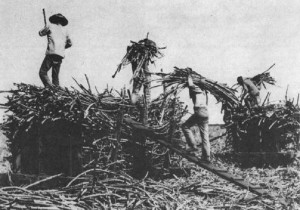For generations sugar production dominated the political, economic, and cultural profile of Hawai`i. At the end of this year the Hawaiian Commercial & Sugar Company, better known as C & H, will process its last crop and lay off its last worker. Parent company Alexander & Baldwin will divide 36,000 acres on Maui into smaller farms with diversified uses and Maui residents will be able to breathe more freely without the annual cane fires that precede harvests. The 144th and last harvest season begins March 2, 2016.
The closure of C & H shouldn’t be a surprise. In 2015 Hawai`i was the third largest sugar producer in the U.S. with 1,422 tons. Florida, the largest American producer, harvested 15,278 tons. Parent company Alexander & Baldwin said it expects to lose $30 million dollars in fiscal year 2015.
If you, like me, associated cane sugar with Hawai`i, one of the reasons could be C & H’s very successful advertising campaign.
Sugar production required a docile labor force – one that would endure harsh conditions in the hope of a better future. Chinese, Japanese, Koreans, Puerto Ricans, Filipinos, Portuguese, Germans, and Norwegians created the multi-ethnic culture of modern Hawai`i.
The work was excruciating. Ronald Takaki in Pau Hana, his book about life on the sugar plantations, quoted one worker’s determination:
The only reason I’m doing
This tough and painful holehole work
Is for the sake of my wife and children
Who live back home.
The history of the plantation era is not romantic. But it is an integral part of what Hawai`i is today. Strange to remember that Kōloa plantation on Kaua`i was the first commercial sugar plantation in the then Kingdom of Hawai`i. In 1980 there were fourteen sugar plantations with another 550 independent sugar growers on 220,000 acres of land. They produced about a million tons of raw sugar annually. In 2017 after 182 years of commercial sugar production, the industry will be gone.
? ? ?
Featured Image. Pu`unene Mill. Hawaiian Commercial & Sugar Company. Maui. Photo by Joanna Orpia. Creative Commons Attribution. Wikimedia Commons.
Photo: Chinese contract laborers loading sugar cane onto a wagon. U.S. Public Domain. Wikimedia Commons.
Olivia Lowenberg. “Why Sugar, Once a Big Business in Hawaii, is Now Disappearing.” The Christian Science Monitor. Jan. 8. 2016. Here.
Alexander and Baldwin Announces Transition of Hawaiian Commercial & Sugar Company to a Diversified Farm Model. Press Release. Honolulu. Jan. 6. 2016.
Grove Farm Sugar Plantation Museum.
Sugar Cane Production in the U.S. Statistica.com
Worker’s quotation in Ronald Takaki. Pau Hana: Plantation Life and Labor in Hawaii. Honolulu: University of Hawaii Press. 1983. p. 90.

Sandra Wagner-Wright holds the doctoral degree in history and taught women’s and global history at the University of Hawai`i. Sandra travels for her research, most recently to Salem, Massachusetts, the setting of her new Salem Stories series. She also enjoys traveling for new experiences. Recent trips include Antarctica and a river cruise on the Rhine from Amsterdam to Basel.
Sandra particularly likes writing about strong women who make a difference. She lives in Hilo, Hawai`i with her family and writes a blog relating to history, travel, and the idiosyncrasies of life.


